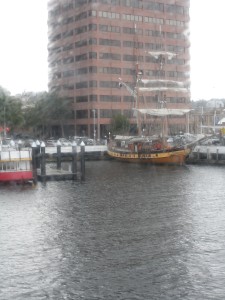January 26 is Australia Day, the anniversary of the first European settlers arrival. In other words, it commemorates the last five – white – minutes of Australian history and disregards the rest. Following the universal general degradation of patriotism to nationalism, it has been co-opted to privilege one version of history over all others. I thought this cartoon about the call on the populace to stop what they’re doing and sing the national anthem at noon was satirical. I was wrong.
And then this morning, heard that the top Australian honour has gone to Prince Philip. Honest. Thank God that these things are handled so ineptly they feed the opposition.
BUT, but but. Something is changing in me and this seems as good as any a day to record it. For example, this is the first post in months, because I no longer experience Australia as a visitor; it’s where I live and work. I’m not really Down Under any more, just here.
I also noticed in my recent role as tourist guide and fellow adventurer with my sister, Kate, on her first visit here over Xmas, I kept saying ‘we do this, we do that, here’. Seeing the now-familiar through her eyes was also instructive, and this post is about some of those observations (pt1).
Kate arrived with a foot infection that worsened over several days, leading to multiple interactions with pharmacists and eventually (successfully) the Emergency Room – every single person was so kind, concerned, helpful and warm. And I felt proud! You can, of course, still find this generosity in the UK, especially in the north of England and outside major cities, but it struggles against the pressures of business and rotten wages and the long years of austerity which have barely touched Australia despite various pleas to tighten belts.
I also had a great time doing touristy things that turned out to not so touristy after all. I assumed Katoomba’s Scenic World would be some kind of sub-Disney tat, but it was brilliant. The thrill seekers took the funicular down and made their way briskly to the Up transport, abandoning the temperate rainforest of the valley floor for us to explore. The interwoven strands of roots and 19th C mining cables were poignant, like traces of a lost civilisation, which I suppose they are.
Admittedly the Jenolan Caves did look more like Disneyworld, on the surface at least, with a kind of Tyrolean look that seemed tenuously connected to the site and its Indigenous stories. But once underground, the magic was way beyond Walt’s imagination, with delicate organic structures as mysterious and beautiful – and old – as this land. Like a visit to the body of the Earth, folded and dark. The guide told the origin stories with such feeling our group of gawkers fell silent and let the tale seep into us like the crystal drips we could hear in the background. And then we emerged to the Blue Lake and fell silent again.
Jenolan Caves
caves
Blue Lake
![WP_20141217_14_54_13_Pro[1]](https://joinoz.wordpress.com/wp-content/uploads/2015/01/wp_20141217_14_54_13_pro1.jpg?w=169&h=300)
![WP_20141217_14_34_46_Pro[1]](https://joinoz.wordpress.com/wp-content/uploads/2015/01/wp_20141217_14_34_46_pro1.jpg?w=300&h=169)
![WP_20141217_14_55_50_Pro[1]](https://joinoz.wordpress.com/wp-content/uploads/2015/01/wp_20141217_14_55_50_pro1.jpg?w=169&h=300)










